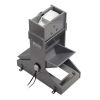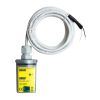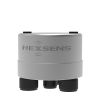KISTERS Single Tipping Bucket Flow Gauges
Features
- Bucket tip volume set at 0.5L or 1L per tip
- Maximum flow rate of 25 liters per minute
- Includes 24VDC dual reed switch
- Expedited repair and warranty service
- Lifetime technical support
- More
Overview
The KISTERS single tipping bucket flow gauges TB0.5L and TB1L are used for measuring water seepage coming out of a pipe or a drain. In both models, the bucket is connected to its own dual reed switch, effectively enabling redundant data acquisition in two distinct data loggers, or providing data to two devices (e.g. a data logger and a counting display), etc.
Design
TB0.5L and TB1L are perfectly suitable for flow measurements in water-carrying sediments or iron hydroxide deposition. Made of plastics and coated steel, these devices are both robust, fast and easy to clean.
Mechanics
The bucket tips when it is filled to maximum. The magnet integrated into the bucket rearside slides along the reed switch mounted in the flow gauge’s frame. The magnetic field forces a contact closure in the reed switch. The latter can be recorded by one or two connected data loggers. The number of tips per time unit is a measure of the flow rate.
| Material | PVC plastic and stainless steel | ||||||||||||||||
| Resolutions | PVC bucket: 0.5 L or 1.0 L (selectable), up to 25 L/minute | ||||||||||||||||
| Accuracy |
|
||||||||||||||||
| Signal Out |
|
||||||||||||||||
| Flow Rate | Maximum 25 L/minute | ||||||||||||||||
| Level | Bulls eye level adhered to stainless steel base | ||||||||||||||||
| Environmental Conditions |
|
||||||||||||||||
| Dimensions & Mass |
|
In The News
From Paddles to Phytoplankton: Studying Vermont’s Wildest Lakes
For six months of the year, Rachel Cray, a third-year PhD student at the Vermont Limnology Laboratory at the University of Vermont, lives between a microscope and her laptop, running data. For the other six months, she is hiking and canoeing four of Vermont’s lakes, collecting bi-weekly water samples. Cray studies algal phenology across four lakes in Vermont, US, that have low anthropogenic stress—or in other words, are very remote. Funded by the National Science Foundation Career Award to Dr. Mindy Morales, the lakes Cray researches part of the Vermont Sentinel Lakes Program, which studies 13 lakes in the area and, in turn, feeds into the Regional Monitoring Network, which operates in the Northeast and Midwest US.
Read MoreReimagining Water Filtration: How Monitoring and Science Enhance FloWater Filtration Systems
Over 50% of Americans think their tap water is unsafe , according to the Environmental Working Group (EWG). Other recent surveys have found that number to be as high as 70% of persons surveyed. Whether due to increased public awareness of water quality issues or confusion about how municipal water sources are regulated, there is a clear distrust of tap water in the United States. According to industry expert Rich Razgaitis, CEO and co-founder of the water purification company FloWater, this issue creates a damaging cycle. Razgaitis explained that the health and environmental problems associated with contaminated water aren’t the only issues. As people become increasingly aware that some tap water is unsafe, they resort to bottled water.
Read MoreMonitoring New Hampshire’s Aquatic Ecosystems: Continuous Data Collection in the Lamprey River Watershed
New Hampshire’s aquatic ecosystems provide a range of ecosystem services to the state and region. Resources and services like clean water, carbon storage, climate regulation, nutrient regulation, and opportunities for recreation all depend on New Hampshire’s aquatic ecosystems remaining healthy. Jody Potter, an analytical instrumentation scientist at the University of New Hampshire (UNH), is studying these aquatic ecosystems in hopes of developing an improved understanding of ecosystem services and their interactions with climate change, climate variability, and land use changes. [caption id="attachment_39799" align="alignnone" width="940"] Aquatic sensors in the Merrimack River in Bedford, NH, with I-293 in the background.
Read More










